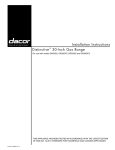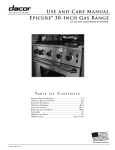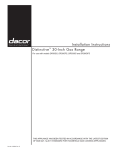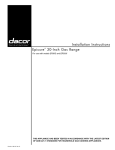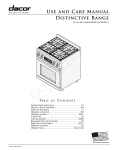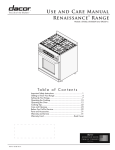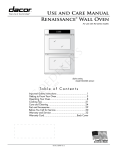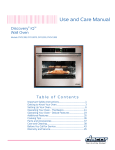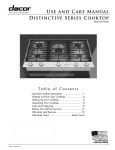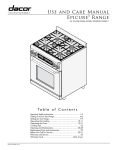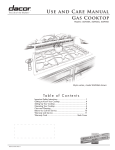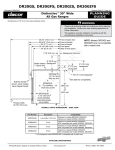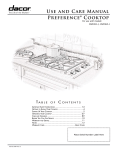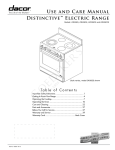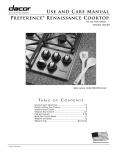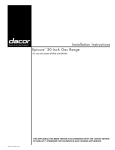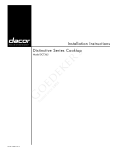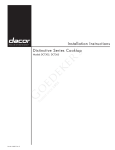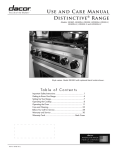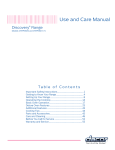Download Dacor Oven DR30GIS User's Manual
Transcript
Use and C are Manual Distinctive 30-Inch Gas Range ™ For use with models DR30GS, DR30GFS, DR30GIS and DR30GIFS Style varies, model DR30GS shown Ta b l e o f C o n t e n t s Important Safety Instructions................................................. 1 Getting to Know Your Range................................................ 4 Setting Up Your Range......................................................... 6 Operating Your Range......................................................... 8 Care and Cleaning........................................................... 14 Before You Call for Service................................................. 18 Parts and Accessories........................................................ 19 Warranty and Service....................................................... 20 Warranty Card..................................................... Back Cover Part No. 105909 Rev. A © 2012 Dacor, all rights reserved Important Safety Instructions Installer: Leave these instructions with the unit. WARNING Consumer: Read this use and care manual completely before using this appliance. Save it for future reference. WARNING: If the information in this manual is not followed exactly, a fire or explosion may result causing property damage, personal injury or death. For service and warranty information, see page 20. - –– Do not store or use gasoline or other flammable vapors and liquids in the vicinity of this or any other appliance. Also keep items that could explode, such as aerosol cans, away from the burners and the oven. Do not store flammable or explosive materials in adjacent cabinets or areas. If you have any questions, call: Dacor Customer Service (800) 793-0093 (U.S.A. and Canada) Monday — Friday 6:00 a.m. to 5:00 p.m. Pacific Time Web site: www.dacor.com Have the model and serial number ready. See page 5 for serial number location. Write the serial number and purchase date below for reference. –– WHAT TO DO IF YOU SMELL GAS • • • • Do not try to light any appliance. Do not touch any electrical switch. Do not use any phone in your building. Immediately call your gas supplier from a neighbor’s phone. Follow the gas supplier’s instructions. • If you cannot reach your gas supplier, call the fire department. –– Installation and service must be performed by a qualified installer, service agency or the gas supplier. Model number ______________________________ Serial number ______________________________ Date of purchase____________________________ Since Dacor continually improves the quality and performance of our products, we may make changes to the appliance without updating this manual. Visit www.dacor.com to download the latest version of this manual. WARNING Important Information About Safety Instructions NEVER use this appliance as a space heater to heat or warm the room. Doing so may result in carbon monoxide poisoning and overheating of the appliance. The Important Safety Instructions and warnings in this manual are not meant to cover all possible problems and situations that can occur. Use common sense and caution when installing, maintaining or operating this or any other appliance. WARNING Tip-over hazard: • A child or adult can tip the range and be killed. Always contact Dacor Customer Service about problems or situations that you do not understand. • Verify that the anti-tip bracket has been properly attached to the floor or wall as directed in the installation instructions. Using a flashlight, verify that the range’s rear leg is engaged with the anti-tip bracket as shown below. Safety Symbols and Labels DANGER • After moving the range, be sure to re-engage the rear leg with the floor or wall mounted anti-tip bracket as shown below. Immediate hazards that WILL result in severe personal injury or death. • Do not operate the range without the rear leg engaged with the anti-tip bracket. WARNING Hazards or unsafe practices that COULD result in severe personal injury or death. • Failure to follow these instructions can result in death or serious burns to children and adults. CAUTION Hazards or unsafe practices that COULD result in minor personal injury or property damage. READ AND SAVE THESE INSTRUCTIONS Anti-tip bracket Rear leg 1 Important Safety Instructions General Safety Precautions To reduce the risk of fire, electric shock, serious injury or death when using your range, follow basic safety precautions, including the following: WARNING WARNING • Do not hang flammable or heat sensitive objects over the range. • If you receive a damaged product, immediately contact your dealer or builder. Do not install or use a damaged appliance. • Have the installer show you the location of the gas shut off valve and the electrical outlet so that you know where and how to turn off the gas supply and disconnect power to the range. • Do not install, repair or replace any part of the range unless specifically recommended in the literature accompanying it. A qualified service technician should perform all other service. • Before performing any type of service, make sure that the gas supply is off and the power cord to the range is disconnected. • Only use this range for cooking tasks expected of a home appliance as outlined in this manual. This range is not intended for commercial use. This appliance is certified only for indoor use. • DO NOT TOUCH THE SURFACES OF THE RANGE DURING OR IMMEDIATELY AFTER USE. After use, make sure these surfaces have had sufficient time to cool before touching them. • NEVER block or cover any slots, holes or passages anywhere inside the oven or on the outside of the range. Doing so blocks airflow through the oven and cooktop and may cause carbon monoxide poisoning or fire. Keep all slots clear of grease and grime. • Do not cover the burners and grates with anything except properly selected utensils. Decorative covers may cause a fire hazard or damage to the cooktop if a burner is accidentally turned on with the cover in place. • Do not heat unopened food containers such as baby food jars and cans. Pressure build up may cause the container to burst and cause injury. • Keep flammable items, such as paper, cardboard, plastic and cloth away from the burners and other hot surfaces. Do not allow pot holders to touch hot surfaces or gas burners. • Do not wear loose or hanging apparel while using the range. Do not allow clothing to come into contact with the range and surrounding areas during and immediately after use. • Use only dry pot holders when removing food and cookware from the cooktop or oven. Wet pot holders can cause steam burns. • If the range is near a window, do not use long curtains as window treatment. The curtains could blow over the cooktop and create a fire hazard. • To avoid the possibility of fire, do not leave the range unattended when in use. • Clean the range thoroughly before operating it for the first time. • In the interest of safety, keep the oven door shut unless inserting or removing food from the oven or when cleaning it. • Do not attempt to use this appliance in the event of a power failure. If a power failure occurs while operating the cooktop, turn all control knobs to the OFF position. • Make sure individuals who use the range are able to operate it properly. • Do not use the oven for storage. • Clean and maintain the range regularly as instructed in the Care and Cleaning section of this manual. Keep the entire range, ventilation filters and range hoods free of grease that could catch fire. • Use cookware only for its intended purpose. Check the manufacture’s recommendations before use to determine if a utensil is suitable for use with a range. Certain types of glass, ceramic and earthenware are not suitable for use with a range. Personal injury or damage may result from the improper use of cookware. • Never allow anyone, including children to sit, stand or climb on any part of the range. Doing so may cause damage, serious injury or death. Do not leave children alone or unattended in the area around the range. Do not allow children to play with the controls, pull on the handle or touch other parts of the range. • Do not store items of interest to children on top of or above the range. Children could be burned or injured while climbing on the appliance. • Select cookware carefully. Use utensils of the proper size, material and construction for the particular type of cooking being done. Utensils need to be large enough to contain the desired quantity of food without boil-overs or spill-overs. Choose pans with easy to hold handles that will stay cool while cooking. Do not use utensils with loose handles. Avoid using pans that are too heavy to lift safely. • Do not tamper with the controls. Do not adjust or alter any part of the range unless specifically instructed to do so in these instructions. 2 Important Safety Instructions WARNING WARNING • When deep fat frying: • Make sure that all the cooktop parts are dry before lighting a burner. ◊ Be certain that the pan is large enough to contain the desired volume of food without overflow caused by the bubbling of the fat. Never leave a deep fat fryer unattended. • Do not use towels or bulky cloth as pot holders. • Use extreme caution if adding water to food on a hot cooktop or oven. The steam can cause serious burns or scalds. ◊ Avoid frying moist or frost-covered foods. Foods with high water content may cause spattering or spilling of the hot fat. • Turn the knobs to the OFF position prior to removing them from the valve stems. ◊ Heat fat slowly, and stir together any combination of oils and fats prior to applying heat. Utilize a deep fat frying thermometer to avoid heating the fat to temperatures above the flash point. • Exercise caution when opening the oven door. Let hot air or steam escape before looking or reaching into the oven. • The cooktop should never be operated without the knobs or trim rings in place. TO REDUCE THE RISK OF INJURY TO PERSONS IN THE EVENT OF A RANGE TOP GREASE FIRE: • Do not allow food to sit in the oven for more than one hour before or after cooking. Eating spoiled food can result in food poisoning. a.SMOTHER FLAMES with a close-fitting lid, cookie sheet or metal tray, then turn off the burner. BE CAREFUL TO PREVENT BURNS. If the flames do not go out immediately, EVACUATE AND CALL THE FIRE DEPARTMENT. • Non-stick coatings, when heated, can be harmful to birds. Remove birds to a separate, well-ventilated room during cooking. b.NEVER PICK UP A FLAMING PAN - you may be burned. • Always ensure that the light fixture lens cover is in place when using the oven. The lens cover protects the light bulb from breakage caused by high oven temperatures or mechanical shock. c.DO NOT USE WATER, including wet dish cloths or towels - a violent steam explosion may result. d.Use a fire extinguisher ONLY if: • Do not operate the range without the backguard attached. A fire hazard may result. ◊ You have a Class ABC extinguisher, and you already know how to operate it. • For your safety, do not use the oven to cook without the convection filter installed. When the filter is not installed, the spinning fan blades at the back of the oven are exposed. ◊ The fire is small and contained in the area where it started. ◊ The fire department is being called. • This appliance is equipped with a three-prong grounding plug for your protection against possible electric shock hazards. If only a two-prong outlet is available, it is the customer’s responsibility to have it replaced with a dedicated, grounded three-prong electrical outlet by a licensed electrician. Do not under any circumstances: ◊ You can fight the fire with your back to an exit. CAUTION • Do not allow acids (citrus juices, tomato sauces, etc.) to remain on the range’s surfaces. The finish may stain. ◊ Cut or remove the third (ground) prong from the power cord. • Never use the cooktop surface as a cutting board. ◊ Use an adapter plug. • Do not expose plastic knobs to direct flame, hot utensils or other sources of heat. ◊ Use an extension cord. ◊ Use a power cord that is frayed or damaged. CALIFORNIA PROPOSITION 65 WARNING ◊ Plug the cooktop into an electrical outlet with a ground fault interrupter (GFI). The burning of gas cooking fuel generates some by-products that are on the list of substances which are known by the State of California to cause cancer or reproductive harm. California law requires businesses to warn customers of potential exposure to such substances. To minimize exposure to these substances, always operate this unit according to the use and care manual, ensuring you provide good ventilation when cooking with gas. 3 Getting to Know Your Range Parts of the Cooktop A BURNER CONTROL KNOBS: Use the knobs to turn on the burners and adjust the flame size. The indicator next to each knob illuminates when a burner is on. The center knob operates the oven. D E C B TRIM RINGS: Located behind each knob, they prevent liquids from getting into the internal parts. F C SPILL TRAY: The spill tray catches any food that falls through the cooktop grates. B D GRATES: The porcelain coated cast iron grates support the cooking utensils during cooking. They are removable to allow the area below and around the burners to be cleaned easily. A E BACKGUARD: Models DR30GS and DR30GFS come standard with a six inch backguard installed. Models DR30GIS and DR30GIFS come standard with a low profile (1 3/4” inch) backguard. The backguard protects the wall from the effects of heat and splattering grease. Optional kits are available to change the size of the backguard for freestanding installations. See the Accessories section. Model DR30GS shown F BURNERS: See below for the size and location of the different burners. The range generates a spark to light the burner when you turn the knob to the HIGH position. Model DR30G (freestanding model) is equipped with full size stainless steel side panels. Model DR30GI is equipped with three inch deep side panels. It is designed for installation in a recessed cabinet or island. Burner Locations and Features Special Cooktop Features A 1300 to 9500 BTU standard burner B 1700 to 15000 BTU standard burner Perma-Flame™: The Perma-Flame instant re-ignition feature automatically re-lights a burner quickly if it goes out. With Perma-Flame, your cooking experience is uninterrupted because the flame is reignited at the same level as when it went out. C 800 to 18000 BTU SimmerSear burner Smart Flame™: Smart Flame technology reduces the temperature under the fingers of the porcelaincoated cast iron grates. Smart-Flame extends grate life and protects the finish. SimmerSear™: The SimmerSear burner is equipped with Dacor’s exclusive precision burner control system. It allows you to cook with a wide range of heat settings, from simmer to sear. 4 Getting to Know Your Range Parts of the Oven A B P C J M Model and serial number label (view through right side of grate with flashlight) N 7 L F 6 5 3 K D 4 2 E F G 1 H J A OVEN CONTROL KNOB: Use the oven control knob to turn on the oven. One knob is used to control both the bake and broil burners. F RACK SUPPORTS: There are seven rack positions inside the oven chamber. The rack positions are numbered from the bottom counting up. B OVEN ON INDICATOR LIGHT: The oven ON indicator light illuminates when the oven is on. The light cycles on and off during normal use indicating that the oven’s burner control system is maintaining a constant temperature. NOTE: When the power plug is first connected, reconnected or after a power outage, this light flashes on and off for about ten seconds while the range’s circuitry starts up. The range is ready to use when the light stops flashing. G DOOR GASKET: The door gasket prevents heat from escaping when the door is closed. C OVEN LIGHT BUTTON: Push in to turn OVEN LIGHT L on and off. L OVEN LIGHT: The oven light is located behind the left oven rack supports. The light turns on or off only when you push the LIGHT BUTTON C . The bulb is 120 Vac, 20 Watt, halogen. H BAKE BURNER: Located below the floor of the oven. It is the source of bottom heat. J INTAKE/EXHAUST VENTS: The range draws air through the vents, cooling its internal parts. K OVEN RACKS: Your oven comes with two chrome-plated GlideRack™ oven racks. D CONVECTION FAN: The convection fan is located behind the convection filter. It circulates heated air through the oven chamber during the convection cooking process. Turn it on and off using the CONVECTION FAN BUTTON P . M BROIL BURNER: The broil burner is the source of top heat. It is mounted in the oven ceiling. N HOT SURFACE IGNITER: The igniter lights the broil burner when broiling. It normally glows orange from time to time during broil operation. E CONVECTION FILTER: The convection filter covers the convection fan. It reduces the transfer of taste from one food to another when you are cooking a whole meal. It also keeps the oven cleaner and covers the moving fan blades for safety purposes. P CONVECTION FAN BUTTON: Turns on the CONVECTION FAN D . 5 Setting Up Your Range Cooktop Assembly The burner rings spread the flame evenly around the burner cap. All burner parts must be properly seated for proper burner lighting and operation. To assemble the burners: 1. Remove the burner rings, burner caps and grates from their shipping packages. 2. Install the burners as shown below. Gently twist each piece back and forth after installation to make sure it is properly seated. A small gap below the burner ring is normal when installed properly. 3. Gently set the grates on top of the spill tray. Put the legs of each grate inside the corresponding dimples. Ridge on bottom STEP 3: Set inner SimmerSear burner cap on center of SimmerSear burner base. Line up ridge on bottom of cap with pins on center of burner base. STEP 2: Set outer SimmerSear burner cap on SimmerSear burner ring. Make sure it is centered on top. STEP 1: Install SimmerSear burner ring on SimmerSear burner base. Line up indentations on bottom of burner ring with pins on top of burner base. Inner burner cap Ridge on bottom of burner cap Outer burner cap STEP 2: Install all standard burner caps. Ridge on bottom of caps must surround top of ring. Burner ring STEP 1: Install standard burner rings on standard burner bases. Put holes on edge of each ring over the igniter. Center tabs on bottom of each ring in hole in center of each base. Pin on burner base SimmerSear Burner Assembly (left front burner only) Igniter hole Burner ring top view Igniter on burner base Standard Burner Assembly (left rear, right front, right rear burners) 6 Setting Up Your Range 2. Begin to slide the rack in, lifting the front safety clips over the front of the oven rack supports. Installing the Oven Racks 3. Push the rack all the way in. WARNING 4. Grasp the rack in the center of the front and pull. The rack should come forward while the guides remain in place. The oven racks become hot when the oven is in use. Your oven comes with Dacor’s deluxe GlideRack oven racks. You can pull then out further than other types of oven racks and still support heavy pots and pans full of food. They are great for heavier foods and the optional Dacor baking stone. To remove an oven rack: • Grasp the rack with both hands and pull it gently straight out toward you until it stops. • Lift up until the front safety clips just clear the front of the rack supports on the oven. Continue to pull out. Moving the end of the rack back and forth slightly, left to right, as you pull, will make it easier to remove. To install an oven rack: 1. Align both sets of safety clips (right and left) on the back of the rack guides with the oven rack supports as shown below. NOTE: The diagram below shows installation with the rack guides extended but, the rack may be installed with or without the guides extended, whichever is easier. Rack guides Lift front safety clips over rack supports Front of rack Slide oven rack supports between back safety clips Rack support Back of guide GlideRack Oven Rack Installation 7 Operating Your Range Cooktop Operation WARNING • To avoid the chance of fire, explosion or carbon monoxide poisoning, do not attempt to use your range without the burners completely and properly assembled (see page 6). The burner rings must be properly seated for proper burner lighting and operation. • To avoid burns and scalding, always turn pan handles to a position where they cannot be easily hit. Also, handles should not extend over adjacent burners. Always set utensils gently onto the grates and center them so that they are well-balanced. • Do not drag cookware across the grates. Sliding may damage the finish. Lift utensils to reposition them. Do not drop them on the grate. • Cookware with rough bottoms can cause permanent damage to the coated surfaces on the grates. • To avoid burns or fire hazard, reduce the flame level if it extends beyond the bottom of the utensil. A flame that extends up the sides of the utensil is potentially dangerous. • In the interest of safety, always light the burner before putting the cooking utensil on the grate. Turn the burner knob to the OFF position before removing the utensil. Always check all the burner knobs to make sure the range is OFF when you are finished cooking. • Do not turn the knob farther than the HIGH position until lit. Doing so may result in a burst of flame that could cause burns or damage to the surrounding area. • Do not touch any part of any of the burners while the igniters are sparking. An electric shock could result. • Never light the burners with a match or other open flame. • If the gas does not ignite after four seconds or if the flame goes out and gas escapes, turn the knob to the OFF position. Open a window and allow at least five minutes for the gas to dissipate. Repeat the lighting procedure. Selecting the Cookware Things to Know Before Using the Cooktop For overall safety and best performance, select the correct cooking utensil for the food being cooked. Improperly selected cooking utensils will not cook evenly or efficiently. • A normal flame is steady and blue in color. Foreign material in the gas line, especially in new construction, may cause an orange flame during initial operation. This color will disappear with further use. Small yellow tips on the ends of the flames are normal when using LP gas. Use cookware that: • Has flat, smooth bottoms. • See page 4 for the heat ranges of the different burners. • Is well balanced. • Has tight fitting lids to keep heat, odors and steam in. • Food cooks just as quickly at a gentle boil as it does at a vigorous, rolling boil. Maintaining a higher boil than necessary wastes energy and cooks moisture, food flavor and nutrients out of the food. • Use a low or medium flame when cooking with utensils that are poor conductors of heat, such as glass, ceramic or cast iron. Reduce the flame until it covers approximately 1/3 of the utensil diameter. Doing so will ensure even heating and reduce the likelihood of burning or scorching the food. IMPORTANT: Avoid spills as much as possible. The porcelain surfaces of the grates, spill trays and burner caps are acid-resistant but not acid-proof. Some foods can cause permanent damage if allowed to remain on porcelain surfaces. • Dacor’s SimmerSear feature allows you precision control of the flame on the SimmerSear burner, from low to high heat. 8 Operating Your Range Lighting a Burner Each burner control knob has a small diagram next to it with an indicator light to tell you which burner it operates. 1. Push in on the knob and turn it counter-clockwise to the HIGH position. The indicator light will illuminate and the burner igniters will spark (a clicking sound) repeatedly until the burner lights. The burner should light within four seconds. The flame should burn evenly around the perimeter of the burner, except underneath each grate support finger, where the flame height is reduced by Dacor’s Smart Flame feature. If the gas does not ignite after four seconds or if the flame goes out and gas escapes, turn the knob to the OFF position. Open a window and allow at least two minutes for the gas to dissipate. Repeat the lighting procedure. Burner knob symbols If a burner still does not ignite, the igniters continue to spark or if the flame is not spread evenly around the burner cap, see the Before You Call for Service section on page 18. 2. Place the cooking utensil on the grate. OFF 3. Adjust the flame to the level necessary to perform the desired cooking process. IMPORTANT: When the cooktop is cool, the igniters may continue to spark if the control knob is set to the low position. The igniters will stop sparking when the burner is warm. The tendency to spark when cold can be reduced by operating the burner at a higher flame setting for about 60 seconds. After 60 seconds, lower the flame to cook. The burner will also warm up faster if a utensil is placed on the grate. The igniters will also spark automatically if the flame is distorted by a draft or by the household ventilation system. Eliminate any drafts or reduce the ventilation blower speed to reduce this type of problem. 9 HIGH LOW Operating Your Range Burning-in the Oven WARNING In broil and convection broil modes, high temperatures (up to 555˚F) are present inside the oven. To avoid the possibility of burns or fire: When the oven comes from the factory, residue for certain materials used in the manufacturing process are left on the parts of the oven. These residues should be “burned off” before the oven is used for the first time. • Broil only with the oven door completely shut. • Do not place food closer than 4 inches from the broil burner. To burn off the residues in the oven: • Keep all other objects (for example potholders) away from the broil burner. 1. Since birds or other small pets may be sensitive to the odors during first operation, remove them to another part of the house and close the door. • After turning the oven knob to BROIL, immediately place the food in the oven and shut the door completely. 2. Open windows and turn on the range hood to allow the odors and smoke to escape. Broiling is a quick cooking process (20 minutes maximum). The range is designed for consumer use conditions only. Do not use it to broil continuously for more than 45 minutes at a time. After 45 minutes in broil mode, turn the oven off and allow it to cool for 30 minutes before broiling again. Leaving the oven in the broil modes for long periods of time may trip the oven’s thermal protection circuit, requiring a service call to reset it. 3. Turn the oven to the BROIL setting for 10 minutes. It is normal for odors and smoke to come out of the vent slot on the backguard during this process. 4. After ten minutes, turn the oven control knob down to 350˚F. Leave the oven at 350˚F for 30 minutes. 5. After 30 minutes, turn off the oven. Close the windows and turn off the range hood when the odors and smoke finish clearing. IMPORTANT: • Before starting the oven, position the oven rack(s) at the proper height(s). If the oven is warm, use potholders for safety. Basic Oven Operation • Condensation may appear on the oven window or the backguard during the first 10 minutes of operation. This condition is normal. You may use your oven to cook in one of the following modes: Bake: The bake process uses the bottom oven To Bake: burner to provide conventional baking heat. Temperatures may be set from 125˚F to 500˚F. Use the standard bake mode for single rack baking. 1. Turn the oven control (center) knob on the control panel to the desired baking temperature. Do not turn the knob all the way to the BROIL setting. The oven ON indicator light will illuminate to indicate the oven is on. Within 60 seconds, the bake burner will ignite. Convection Bake: The convection bake process uses the standard bake burner in combination with the convection fan to circulate heated air evenly throughout the oven chamber. Temperatures may be set from 125˚F to 500˚F. This type of baking is good for single rack baking in a deep pan, multiple rack baking and roasting. Oven burner light on control panel Broil: The gas burner on the oven ceiling sup- plies the heat from the top for broiling. This process is good for grilling smaller cuts of meat and toasting breads. Broiling is always performed with the oven door completely shut. 2. For best results, do not place food inside the oven until the oven has preheated to the set temperature. When pre-heated to the set tem7 perature, the oven ON indicator light will begin 6 on and off every few seconds, because to turn the set 5 temperature has been reached and the oven is maintaining it. Convection Broil: The convection broil process uses the gas burner on the oven ceiling in combination with the convection fan for better heat distribution. Convection broil is good for items that do not need to be flipped such as thinner cuts of meat, fish and garlic bread. Convection broiling is always performed with the oven door completely shut. 4 3 1 10 2 Operating Your Range To Convection Bake: 3. Immediately place the food inside the oven and shut the door completely. 1. Pre-heat the oven according to the Bake instructions on the facing page. IMPORTANT: • Always use a broiler pan and grill to provide drainage for excess fat and grease. Doing so will reduce spatter, smoke and flare-ups. 2. When pre-heated, place the food in the oven. 3. Close the oven door and push the convection fan button to turn it on. NOTE: Push the button again to turn the fan off when you are done cooking. • The igniter for the broil burner on the ceiling of the oven will glow orange periodically during normal broil operation. To Broil: To Convection Broil: 1. Adjust the rack position based on the food thickness. Dacor recommends rack levels 4 or 5. 1. Set the oven to broil according to the Broil instructions at the left. 2. Turn the oven control (center) knob on the control panel to the BROIL setting. The oven ON indicator light will illuminate to indicate the oven is on. Within 60 seconds, the burner (on the ceiling) will ignite. While the broil burner is on, the bake burner is off. 2. Immediately place the food inside the oven and shut the door completely. 3. Push in on the CONVECTION FAN button on the right side of the control panel to turn on the convection fan (push in again to turn off). Baking Tips Tips for All Baking Modes • Wait until the shortest recommended baking time before checking food. For cakes, a wooden pick placed in the center should come clean when the food is done. • Do not open the oven door frequently during baking. Look through the door window to check the progress of baking whenever possible. • Measure ingredients carefully and follow tested recipes for best baking results. • Use a timer to time baking functions. COMMON PROBLEMS WHEN USING STANDARD BAKE MODE Problem Cookies burn on the bottom. May Be Caused By What to Do Oven door opened too often. Set timer to shortest recommended cooking time and check food when timer beeps. Use door window to check food. Incorrect rack position used. Change rack position. Dark, heat absorbing cookie sheets used. Use shiny, reflective cookie sheets. Rack position being used is too high. Change rack position. Food placed in oven during preheat. Wait until oven is preheated. Cakes burn on the sides or are not done in the center. Oven temperature too high. Reduce oven temperature. Cakes crack on top. Oven temperature too high. Reduce oven temperature. Cakes are not level. Oven and/or oven rack not level. Level oven and rack as needed. Pies burn around the edges or are not done in the center. Oven temperature too high. Reduce oven temperature. Dark, heat absorbing pans used. Use shiny, reflective pans. Oven and/or rack overcrowded. Reduce number of pans. Cookies are too brown on top. Dark, heat absorbing cake pans Use shiny, reflective cake pans. used. 11 Operating Your Range Bakeware Tips Baking Tips (cont.) • Dacor’s optional full-sized cookie sheets maximize baking capabilities by utilizing the most usable rack space. See the Accessories section for ordering information. Convection Bake Tips • As a general rule, convection bake will allow preparation of most foods at reduced temperatures for shorter periods of time, while also producing superior results. • Use the pan size and type recommended by the recipe to ensure best results. • Cakes, quick breads, muffins and cookies should be baked in shiny, reflective pans for light, golden crusts. • Typically you can reduce the standard temperature by 25˚F and cook for 10% less time. Baked goods will have golden-brown crusts with flaky textures, and meats will have crispy exteriors with succulent juices sealed inside. • Medium gauge aluminum sheets with low sides should be used when preparing cookies, biscuits and cream puffs. • To convert conventional bake recipes to convection recipes, reduce the temperature by 25˚F and the cooking time by approximately 10%. • Bake most frozen foods in their original foil containers placed on a flat cookie sheet. Follow the package recommendations. • Some recipes, especially those that are homemade, may require adjustment and testing when converting from standard to convection modes. If unsure how to convert a recipe, begin by preparing the recipe in bake mode. After achieving acceptable results, follow the convection guidelines above. If the food is not prepared to your satisfaction during the first convection trial, adjust only one recipe variable at a time (such as cooking time, rack position or temperature) and repeat the convection test. If necessary, continue adjusting one recipe variable at a time until you achieve satisfactory results. • When using glass bakeware, reduce the recipe temperature by 25˚F, except when baking pies or yeast breads. • Follow the standard recipe baking time for pies and yeast breads. • Avoid the use of old, darkened pans. • Warped, dented, stainless steel and tin-coated pans heat unevenly and will not give uniform baking results. • Place pans carefully on the oven racks. Turn pans on the racks so that the long sides run left to right, parallel to the door. About Convection Baking... The Dacor convection cooking system distributes the heated air evenly to ensure uniform results. It also channels the air evenly into the oven, eliminating any hot or cool spots. Food Placement You can utilize more oven capacity due to the uniform air circulation provided by convection cooking. Many foods, such as pizzas, cakes, cookies, biscuits, muffins, rolls and frozen convenience foods can be successfully prepared on either two or three racks* at the same time. Also, complete meals can be prepared by using multiple racks. See below for specific recommendations. AIR FLOW *The range comes with two racks. Additional racks are available from your dacor dealer, see page 20. • Typically, when baking on two racks with your oven, use rack positions #3 and #5 (counting from the bottom up). When baking on three racks, use rack positions #2, #4 and #6. • When adapting a single rack recipe to multiple rack baking, it may be necessary to add to the baking time. This is due to the extra amount of food in the oven. • Turn pans on the racks so that the long sides run left to right, as you face them. • Heavier roasting pans and dishes will cook better on rack position #1. 12 Operating Your Range • When using a optional baking stone, use rack position #3 for best results. • Dacor recommends that you set a timer to time the broiling process. • When using a meat thermometer, insert the probe halfway into the center of the thickest portion of the meat. For poultry, insert the thermometer probe between the body and leg into the thickest part of the inner thigh. To ensure an accurate reading, the tip of the probe should not touch bone, fat or gristle. Check the meat temperature 2/3 of the way through the recommended roasting time. After reading the meat thermometer once, insert it 1/2 inch further into the meat, then take a second reading. If the second temperature registers below the first, continue cooking the meat. • Start with a room temperature broiler pan for even cooking. • Allow roasts to stand 15 to 20 minutes after roasting in order to make carving easier. • Use tongs or a spatula to turn and remove meats. Never pierce meat with a fork because the natural juices will escape. • Roasting times always vary according to the size, shape and quality of meats and poultry. Less tender cuts of meat are best prepared in bake mode and may require moist cooking techniques. Follow your favorite cookbook recipes. Broiling Tips Broiling is a quick and flavorful way to prepare many foods, including steaks, chicken, chops, hamburgers and fish. It is normal and necessary for some smoke to be present to give the food a broiled flavor. • Broil food on the first side for a little more than half of the recommended time, then season and turn. Season the second side just before removing the food from the oven. High Altitude Cooking • To prevent sticking, lightly grease the broiler grill. Excess grease will result in heavy smoke. For easier cleaning, remove the broiler pan and grill when the food is removed. Due to the lower atmospheric pressure at higher altitudes, foods tend to take longer to cook. Therefore, recipe adjustments should be made in some cases. In general, no recipe adjustment is necessary for yeast-risen baked goods, although allowing the dough or batter to rise twice before the final pan rising develops a better flavor. Try making the adjustments below for successful recipes. Take note of the changes that work best and mark your recipes accordingly. You may also consult a cookbook on high altitude cooking for specific recommendations. Roasting Tips • Dacor’s optional roasting pan works particularly well and two of them will fit side by side in your oven. • For roasting, Dacor’s optional “V” shaped rack and broil/roast pan works best to allow air circulation around the food. • If using a cooking bag, foil tent or other cover, use convection bake mode. Adjust the recipe time and temperature as well. 13 Altitude (feet) Baking Powder for each teaspoon decrease by: Sugar for each teaspoon decrease by: Liquid, for each cup add: 3000 5-10% 10-25% 5-10% 5000 10% 10% 20% 7000 25% 20% 20-25% Care and Cleaning To keep the range looking and operating its best, clean it after every use. Also, wipe up spills that occur while cooking quickly. Be careful not to touch any hot areas. Cleaning WARNING If you allow spills to sit on hot burner parts, they will burn on and be very difficult to clean. Certain types of food, such as tomatoes, citrus juices, vinegar, alcohol and milk can damage the finishes if you allow them to stand for any length of time. • Clean only the parts of the range listed in this manual. Clean them only in the manner specified. • To avoid dangerous fumes or damage to your range’s surfaces and accessories, use only the types of cleaning solutions specified in this manual. Cooktop Disassembly and Cleaning • To avoid electrical shock or burns, turn off the burners and oven and make sure that all parts are cool before cleaning. DO NOT turn the burners on during cleaning. 1. Disconnect the power cord. 2. When the range is cool, remove the grates from the top of the cooktop. • Do not use a steam cleaner to clean the range. Steam could penetrate the electrical components and cause a short circuit. 3. Disassemble the burners: Lift the burner caps and burner rings off of the burner bases. • To reduce the chance of electric shock, disconnect the range power cord from the electrical outlet before cleaning. • Do not try to remove heavy spills with a sharp object such as a knife or metal spatula. Sharp objects may scratch your range’s surfaces. • To prevent damage, do not use abrasive or corrosive cleaners or applicators such as steel wool or scouring pads on any part of the range unless instructed to do so. Use only a sponge, soft cloth, fibrous or plastic brush or nylon cleaning pad for cleaning the surfaces of your range. • Ensure that the anti-tip bracket is engaged after the range is moved out for cleaning. Use a flashlight to look underneath the range and verify that the anti-tip bracket covers the rear leg when the range is moved back into place. Grates and Spill Trays IMPORTANT: DO NOT use any of the cleaners listed below to clean the burners and igniters. See the facing page for burner and igniter cleaning instructions. The grates and spill tray are coated with a porcelain finish. • For everyday cleaning, use a soft cloth or nonabrasive pad with warm soapy water to clean all of the porcelain parts. • If necessary, tough stains may be removed by applying full-strength sprays such as Simple Green™, Ajax™ All-Purpose Cleaner or Formula 409™. To minimize wear, use the mildest cleaner needed to get the surface clean. Anti-tip bracket Rear leg IMPORTANT: The cooktop is exposed to extremely high temperatures. The grates are under high stress when hot utensils are placed on them. Also, the range parts are occasionally exposed to acidic food spill-overs. These severe operating conditions cause the porcelain enamel parts on your range to undergo a change in appearance over time. If you care for and clean these parts carefully, you will slow down, but not eliminate, the aging process. • For extremely stubborn stains, you may use a mildly abrasive cleaner or applicator, such as Soft Scrub™, Bon Ami™, S.O.S.® pads or other soap-filled steel wool pads. Use these cleaners with extreme care and only on occasion. Aggressive or extensive use of these types of abrasives will damage the finish. Finish damage due to the use of abrasives is not covered under your warranty. 14 Care and Cleaning Cleaning the Burners and Igniters WARNING Inner burner cap Use care while cleaning the igniters. The porcelain is fragile and can crack or break. IMPORTANT: The igniters will not work properly if the burner rings, burner bases or igniters are not clean. Dirty or wet igniters may not spark at all. Outer burner cap After disassembling the burners, check for any dirt or grime deposited on the individual parts, including the igniters. 1. Using a firm toothbrush, clean completely around the metal top and porcelain base of each igniter. Use care while cleaning because the porcelain is fragile and can crack or break. Do not use water to clean the igniters. If necessary, use a small amount of rubbing alcohol to help dissolve grime. Burner ring Igniter Burner base 2. Examine the burner rings. Remove anything stuck in the holes with a straightened paper clip, wire or needle. Be careful not to scratch or damage it. Do not distort the shape of the holes. SimmerSear Burner (left front burner only) 3. Clean all the burner rings, with window cleaner or rubbing alcohol. Use a cleaning brush with plastic bristles or a firm tooth brush. When done, rinse the parts well with clean water. Dry all the parts thoroughly before re-assembling them. 4. Clean the burner caps with a solution of mild detergent and hot water. Burner cap 5. Reassemble the cooktop in the reverse order (see page 6 for detailed instructions). Make sure you line up the notches on the burner rings. 6. Re-connect the power cord and test the burners after reassembling them. If the flame is uneven, be sure that all the burner parts are properly positioned, then check for any remaining dirt or grime on the burner parts or igniter. If erratic clicking is still present, make sure the igniter is completely dry. If the unit still exhibits problems after drying, call your local Dacor authorized service agent. Burner ring Igniter Burner base Standard Burner (right front, right rear, left rear burners) 15 Care and Cleaning Chrome Surfaces Cleaning (cont.) Clean chrome surfaces the same way as stainless steel surfaces (see column one). Knobs and Trim Rings Porcelain Surfaces WARNING The oven interior, the inner side of the oven door and the spill tray are finished in porcelain enamel. • Do not operate the cooktop without the knobs and spill protector rings in place. Clean porcelain surfaces with a solution of mild detergent and hot water. Rinse and dry with a soft cloth. Do not use abrasives or commercial oven cleaners. • Do not soak the knobs and spill protector rings in water or place them in the dishwasher. • Do not expose plastic knobs to direct flame, hot utensils or other sources of heat. Oven Racks Wash the knobs regularly with a solution of warm soapy water. Dacor recommends hand dishwashing liquid. To clean: The GlideRack oven racks are chrome-plated. For everyday cleaning, apply a solution of detergent and hot water. To clean heavy soil, use the rough side of a sponge or a scouring pad with plenty of water, or use a solution of 1 cup ammonia to 2 gallons of water. 1. Disconnect power and turn the knobs to the OFF position. 2. Grasp each knob and pull straight back, off of the valve shaft. Broil Burner 3. Clean the outside edges of the trim rings while the knobs are removed. Wipe them with a soft damp rag. WARNING To prevent damage to the broil burner and broil burner igniter, do not spray it with any type of cleaner or attempt to scrub them in any manner. These parts are self-cleaning and do not require any type of maintenance. 4. To replace the knobs, align the “D-shaped” opening on the back of the knob with the end of the valve shaft. Carefully push the knob on until it stops. The largest knob with numbers on it is the oven knob and goes on the center valve stem. The SimmerSear burner knob has the high flame icon and the simmer (low) icon spaced further apart than the other three burner knobs. Place it on the valve stem that is second from the left. To burn off any grime build-up on the broil burner and igniter, close the oven door and turn the oven control knob to the BROIL position for about ten minutes. After ten minutes turn the oven off. Door Gasket (Seal) Clean the door gasket by dabbing it with a solution of water and mild soap. Do not scrub it or it will become damaged. Door Gasket (Seal) 5. Reconnect the power cord. Clean the door gasket by dabbing it with a solution of water and mild soap. Do not scrub it or it will become damaged. Door Glass Clean all glass surfaces with a solution of mild detergent and hot water. Use a mild glass cleaner to remove fingerprints or smears. Dry completely with a soft, lint-free cloth. Convection Filter WARNING Stainless Steel Surfaces For your safety and proper oven performance, re-install the filter before using the oven to cook. If you don’t, the spinning fan blades at the back of the oven will be exposed. The control panel, the outside surface of the oven door, the area around the outside of the cooktop and the side panels are covered with stainless steel. Clean these surfaces with the provided Dacor Stainless Steel Cleaner. Rinse and dry with a soft, lint-free cloth. Always wipe stainless steel surfaces with the grain. A small amount of baby oil may be applied to stainless steel tops to restore lustre. The convection filter is located in the back of each oven chamber. Clean the filter regularly. If you allow it to become clogged, the oven’s convection cooking modes will not work properly. 16 Care and Cleaning Removing your oven’s convection filter... Light bulb replacement is considered a homeowner maintenance operation. If the light does not work, before replacing it, please consult the Problem Solution Guide on page 18. When the oven is cool, put your fingers around the edges of the filter and gently push up. 1. Replace the light bulb only with Dacor part number 107112. See page 20 for ordering information. IMPORTANT: Do not touch the replacement halogen light bulb with your fingers. Halogen bulbs are sensitive to the oils from your hand. The oils from your hand will stick to the bulb and may cause it to burn out faster than normal. 7 6 5 4 3 2 1 2. Disconnect the range power cord from the electrical outlet. 3. Hold your hand under the lens for support and gently pry it loose using a spatula or table knife. Pull the lens cover straight out. To clean the filter... Soak it in hot, soapy water. Rinse well. You may also place it in a dishwasher on the top rack. Dry the filter before re-installing it. Light fixture Bulb Installing your oven’s convection filter... Carefully hook the metal clips on the back of the filter on the slots on both sides of the fan hole. Be careful not to scratch the porcelain surfaces with the back of the filter. Light socket Lens cutout Clips Lens Slots 4. Grasp the old bulb and pull it straight out of the socket. Replacing the Oven Light 5. Using a glove, insert the new bulb into the socket. WARNING • To prevent an electrical shock hazard and/or personal injury, make sure that power to the range has been disconnected and that the light fixture is cool before replacing the light bulb. 6. As you reinstall the lens cover, line up the cutout on the inside rim with the light socket. Gently press it into its original position. 7. Reconnect the power cord. • Always ensure that the lens cover is in place when using the oven. The lens cover protects the bulb from breakage caused by high oven temperatures or mechanical shock. • Replacing the lens cover without lining up the cutout with the light socket will damage the light fixture. • Do not use a screwdriver to remove the lens. 17 Before You Call for Service Problem Nothing works. Igniters do not spark. No flame. Burner goes out at low setting. May Be Caused By Range not connected to electrical power. Check to make sure range power plug is connected to electrical outlet. Power is off. Turn on power at circuit breaker or fuse box for electrical outlet range is connected to. Check for tripped breaker or blown fuse. Power outage. Contact power company. Power not supplied to unit. See Nothing Works above. Wet or dirty igniter(s). Clean and dry igniters and burner assemblies according to Care and Cleaning section. Igniter(s) not working (no click- See Igniters do not spark above. ing sound). Wet or dirty igniter(s). Clean and dry according to Care and Cleaning section. Gas is turned off. Make sure the gas supply valve is in the “ON” position. Gas supply interrupted. Contact gas company. Low gas pressure. Contact gas company to have pressure tested. Air intake holes obstructed. Check to make sure none of the air vents or slots on range are obstructed. Flame is distorted, yellow or Burner parts are dirty or very large. clogged. Igniters continue to spark (click) after flame ignites. Orange glow on ceiling of oven when broiling. What to Do Clean and dry according to Care and Cleaning section. Burner parts are not properly positioned. Make sure burner is assembled according to the Setting Up Your Range section. Range set up to use a different type of gas (natural or LP) or set up for different altitude. Have a qualified service technician check to make sure that the range is set up for the type of gas and the correct altitude. Gas regulator is not installed or faulty. Have a qualified service technician check the gas regulator. Burner is cold. Burners may continue to spark for up to 60 seconds when cold and set to low. See Operating Your Range section for more information on how to minimize. Flame distorted by air draft. Minimize any air drafts around the cooktop. Close nearby windows. Wet or dirty igniter(s). Clean and dry according to Care and Cleaning section. Burner parts wet or dirty. Clean and dry according to Care and Cleaning section. Burner parts not properly positioned. Make sure burner is assembled according to the Setting Up Your Range section. Power supply polarity is reversed or not properly grounded. Have a licensed electrician check the electrical outlet. Normal operation. The broil burner hot surface igniter glows orange off and on when the oven knob is set to broil. 18 Before You Call for Service Problem Oven will not heat when turned on. May Be Caused By What to Do No power to range. See Nothing Works on facing page. Gas is turned off. Make sure the gas supply valve is in the “ON” position. Gas supply interrupted. Contact gas company. Oven light will not work. Light bulb is burned out. See Care and Cleaning section. Oven light will not turn off. Orange glow inside oven. Broil burner hot surface igniter is on. The broil burner hot surface igniter glows orange (off and on) during broil. Normal operation. Oven ON indicator light goes on and off repeatedly. Normal operation. The oven ON indicator light illuminates when the oven is on. The oven burner control system turns the oven off and on to maintain the temperature set by the oven control knob. Foods over-cook. Incorrect cooking time, temperature. Adjust time, temperature or rack position. Foods under-cook. Incorrect cooking time, temperature Adjust time, temperature or rack position. Condensation on oven door window Cold weather. During cold weather it is normal for condensation to appear on the oven door window during the first 10 minutes of operation. Strange odor when oven is on. Residue in oven. During manufacturing, certain residues can be left on oven surfaces. Oven needs to be “Burned In.” See page 7. 19 Parts and Accessories Description Dacor Part Number Wok ring AWR4 Cooktop griddle AGDG14 Large capacity roast/broil pan with “V” shaped rack AORPVR Cooktop grill AGRG14 Standard broil pan and broil pan grill AER30BP Pizza baking stone ABS16 Cookie sheets (3 per carton) ACS303 Gliderack oven rack 701464* Low profile (1 3/4”) backguard kit AER30GLBG 3” backguard kit AERB30G03** 6” backguard kit AERB30G06** 9” backguard kit AERB30G09** 14” grate (2 used per unit) 101524 Halogen light bulb (120 Volt, 20 Watt) 107112 Dacor Stainless Steel Cleaner A302 *Part number shown is for warranty/repair replacement. To order additional racks for non-repair purposes, order part number ARGO30H. **Compatible with models DR30GS and DR30GFS only. To order parts and accessories, contact your Dacor dealer or visit www.everythingdacor.com. Warranty and Service Getting Help Before you request service: 1. Review the Before You Call For Service section of this manual (page 18). 2. Use the helpful tips found in our Problem Solution Guide. 3. Become familiar with the warranty terms and conditions of your product. 4. If none of these tips or suggestions resolves your problem, call our Customer Service center at the number below. Dacor’s Customer Service center is available 6:00 a.m. – 5:00 p.m. Pacific Time For warranty repairs or questions and for Dacor Distinctive Service (DDS) in the US and Canada Phone: (800) 793-0093, extension 2822 For non-warranty repairs or questions in the US and Canada Phone: (800) 793-0093, extension 2813 Contact us through our web site at: www.dacor.com/contact-us 20 Warranty and Service What Is Not Covered Warranty • Slight color variations may be noticed because of differences in painted parts, kitchen lighting, product placement and other factors; this warranty does not apply to color variation. • Service calls to educate the customer on proper use and care of the product. • Service fees for travel to islands and remote areas, which include but are not limited to, ferries, toll roads or other travel expenses. • Consequential or incidental damage, including but not limited to food or medicine loss, time away from work or restaurant meals. • If your Dacor product fails to function within one year of the original date of purchase, due to a defect in material or workmanship, Dacor will remedy it without charge to you. Failure of the product when used for commercial, business, rental or any application other than for residential consumer use. • Failure of the product caused by improper product installation. All cosmetic damage (such as scratches on stainless steel, paint/porcelain blemishes, etc.) to the product or included accessories must be reported to Dacor within 60 days of the original purchase date to qualify for warranty coverage. • Replacement of house fuses, fuse boxes or resetting of circuit breakers. • Damage to the product caused by accident, fire, flood, power interruption, power surges or other acts of God. • Liability or responsibility for damage to surrounding property including cabinetry, floors, ceilings and other structures or objects around the product. • Breakage, discoloration or damage to glass, metal surfaces, plastic components, trim, paint or other cosmetic finish caused by improper usage, care, abuse, or neglect. What Is Covered CERTIFICATE OF WARRANTIES: DACOR RANGES WITHIN THE FIFTY STATES OF THE U.S.A., THE DISTRICT OF COLUMBIA AND CANADA*: FULL ONE-YEAR WARRANTY The warranty applies only to the Dacor appliance sold to the first use purchaser, starting from the date of original retail purchase or closing date for new construction, whichever period is longer. Warranty is valid on products purchased brand new from a Dacor Authorized Dealer, or other seller authorized by Dacor. Consumable parts such as filters and light bulbs are not covered and are the responsibility of the purchaser. LIMITATIONS OF COVERAGE Service will be provided by a Dacor designated service company during regular business hours. Please note service providers are independent entities and are not agents of Dacor. Out of Warranty Dealer display and model home display products with a production date greater than 5 years, products sold “As Is,” and products installed for non-residential use, which include but are not limited to religious organizations, fire stations, bed and breakfast and spas carry a one year parts warranty only. All delivery, installation, labor costs, and other service fees are the responsibility of the purchaser. Should you experience a service issue beyond the standard warranty period, please contact us. Dacor reviews each issue and customer concern to provide the best possible solution based on the circumstances. THE REMEDIES PROVIDED IN THE ABOVE EXPRESS WARRANTIES ARE THE SOLE AND EXCLUSIVE REMEDIES. THEREFORE, NO OTHER EXPRESS WARRANTIES ARE MADE, AND OUTSIDE THE FIFTY STATES OF THE UNITED STATES, THE DISTRICT OF COLUMBIA AND CANADA, ALL IMPLIED WARRANTIES, INCLUDING BUT NOT LIMITED TO, ANY IMPLIED WARRANTY OF MERCHANTABILITY OR FITNESS FOR A PARTICULAR USE OR PURPOSE, ARE LIMITED IN DURATION TO ONE YEAR FROM THE DATE OF ORIGINAL PURCHASE. IN NO EVENT SHALL DACOR BE LIABLE FOR INCIDENTAL EXPENSE OR CONSEQUENTIAL DAMAGES. IN THE EVENT DACOR PREVAILS IN ANY LAWSUIT, DACOR SHALL BE ENTITLED TO REIMBURSEMENT OF ALL COSTS AND EXPENSES, INCLUDING ATTORNEY’S FEES, FROM THE DACOR CUSTOMER. NO WARRANTIES, EXPRESS OR IMPLIED, ARE MADE TO ANY BUYER FOR RESALE. Warranty will be null and void on product that has altered, defaced or missing serial numbers and tags. The owner must provide proof of purchase or closing statement for new construction upon request. All Dacor products must be accessible for service. *Warranty is null and void if non-ETL or non-CUL approved product is transported from the U.S.A. OUTSIDE THE FIFTY STATES OF THE U.S.A., THE DISTRICT OF COLUMBIA AND CANADA: LIMITED FIRST YEAR WARRANTY If your Dacor product fails to function within one year of the original date of purchase due to a defect in material or workmanship, Dacor will furnish a new part, F.O.B. factory to replace the defective part. Some states do not allow limitations on how long an implied warranty lasts, or do not allow the exclusion or limitation of inconsequential damages, therefore the above limitations or exclusions may not apply to you. This warranty gives you specific legal rights, and you may also have other rights that vary from state to state. All delivery, installation, labor costs and other service fees are the responsibility of the purchaser. 21 Notes 22 Notes 23 Notes 24 fold here NO POSTAGE NECESSARY IF MAILED IN THE UNITED STATES BUSINESS REPLY MAIL FIRST-CLASS MAIL PERMIT NO 1600 CITY OF INDUSTRY CA POSTAGE WILL BE PAID BY ADDRESSEE DACOR ATTN WARRANTY PROCESSING DEPT PO BOX 90070 CITY OF INDUSTRY CA 91715-9907 Please visit www.dacor.com to activate your warranty online. WARRANTY INFORMATION IMPORTANT: Please rest assured that under no conditions will Dacor sell your name or any of the information on this form for mailing list purposes. We are very grateful that you have chosen Dacor products for your home and do not consider the sale of such information to be a proper way of expressing our gratitude! Owner’s Name: Street: Last (Please Print or Type) First City: Middle State: Purchase Date: Email: cut here Your warranty will not be activated until you activate it online or return this form to Dacor. If you have purchased more than one Dacor product, please return all forms in one envelope or activate the warranty for each product online. Zip: Telephone: Dealer: City: State: Zip: Your willingness to take a few seconds to fill in the section below will be sincerely appreciated. Thank you. 1. How were you first exposed to Dacor products? (Please check one only.) A. T.V. Cooking Show F Builder B. Magazine G. Architect/Designer C. Appliance Dealer Showroom H. Another Dacor Owner D. Kitchen Dealer Showroom I. Model Home E. Home Show J. Other D. Builder E. Other 3. For what purpose was the product purchased? A. Replacement only B. Part of a Remodel C. New Home D. Other 4. What is your household income? A. Under $75,000 B. $75,000 – $100,000 C. $100,000 – $150,000 D. $150,000 – $200,000 E. $200,000 – $250,000 F. Over $250,000 5. What other brands of appliances do you have in your kitchen? A. Cooktop C. Dishwasher B. Oven D. Refrigerator 6. Would you buy or recommend another Dacor product? Yes Comments: No Thank you very much for your assistance. The information you have provided will be extremely valuable in helping us plan for the future and giving you the support you deserve. Web site: Corporate phone: www.dacor.com (800) 793-0093 cut here 2. Where did you buy your Dacor appliances? A. Appliance Dealer B. Kitchen Dealer C. Builder Supplier




























